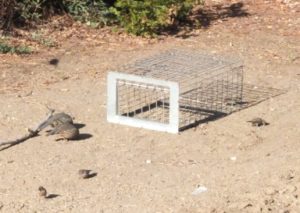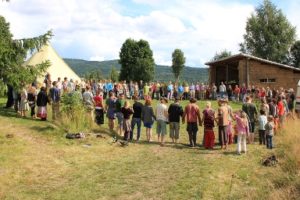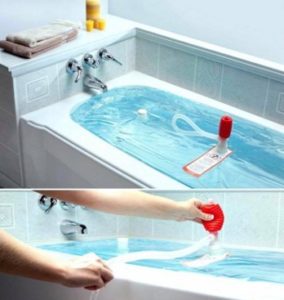 Ask any competent prepper and they’ll tell you that the first rule of prepping is to keep your mouth shut about your prepping. In other words, you need to be practicing stealth prepping. The reason is simple – when SHTF, you don’t want everyone and their brother showing up at your house looking for stuff. You don’t want random strangers (potential looters) knowing about your preps and where you live. It’s a HUGE safety and security list to let random people know about your prepping activities.
Ask any competent prepper and they’ll tell you that the first rule of prepping is to keep your mouth shut about your prepping. In other words, you need to be practicing stealth prepping. The reason is simple – when SHTF, you don’t want everyone and their brother showing up at your house looking for stuff. You don’t want random strangers (potential looters) knowing about your preps and where you live. It’s a HUGE safety and security list to let random people know about your prepping activities.
Stealth Prepping in the Public Domain
It’s really easy to practice stealth prepping – just know when to STFU. Don’t show off all your “cool stuff.” Don’t brag about all your “prepping expertise.” In fact, if you’re bragging about it, you don’t really have anything to brag about. Resist the urge to post pics of all your stuff on Facebook or Instagram. Don’t post vids of you and all your stuff on YouTube. Really simple, right?
OTOH, I don’t think you need to be paranoid about paying for stuff with a credit card. I seriously doubt that some government employee somewhere is scouring my purchase receipts every month looking for “suspicious” purchases.
Stealth Prepping in the Family
What I want to talk about mostly though is stealth prepping in the context of a family budget when your wife isn’t a prepper. I still remember the time I was shopping with my wife and tried to buy five cases of purified drinking water. No matter how urgent you personally feel the need for prepping is, if you’re spending from a family budget you need to keep your spouse’s budget concerns in mind. In other words, practice stealth prepping in the family.
But Honey, It’s Not Prepping…
So how do you get your wife to spend money prepping when she’s not a prepper? Maybe she’s even hostile to the idea of prepping? Easy. Just don’t call it prepping. My wife didn’t want me to buy a small emergency water store, so we bought a Berkey water purification system instead. Five cases of water would have cost less than $25 and the Berkey system cost almost $350. Why did she agree to spend so much on the Berkey system? Because in her mind, storing water is prepping but having a water purification system isn’t.
Stealth Prepping in Practice
I decided to apply this “not prepping” concept to all my preps. For example, the Berkey is a nice system, but it just filters water – it doesn’t create water. In other words, I still need to store water, but that’s prepping. So instead of “storing water,” I’m going to put in a backyard pond that will hold over 1000 gallons – far more than the paltry 30 gallons my wife didn’t want me to get at Walmart. And guess what? She’s ecstatic about the idea of having a pond in our backyard. She’s also excited about the rainwater catchment system we’re planning. That’s not prepping either – it’s free water for our garden. Are you starting to see how this works?
Food is even easier – my wife is frugal, so all I have to do is watch the ads for things I like to eat that have good shelf life. It’s OK with her to stock up then because we’re not storing extra food, we’re saving money. Our garden produced more food this year than we can use, so soon that will be a reason for canning jars and a dehydrator. I’m still working on an excuse to get a smoker though…
Gear is more difficult. It doesn’t save money and she can’t picture any circumstance that might force us from our home. Besides if something happened we could just stay in a motel, right? What I’ve found out helps with gear is hobbies – you just have to pick the right hobbies. For example, some of my hobbies are hiking, camping, hunting, fishing, and target shooting. You shouldn’t be surprised that the gear I use for those things just happens to be useful for prepping as well.
Final Thoughts…
Finally, when buying your preps, either go big or go small. When we bought our Berkey system, we went all out. Besides the basic system, I threw in chlorine/arsenic filters, a stand, and a few stainless steel water bottles. Since it was already a big purchase, she didn’t balk at the extra items. At the same time, I’ve found out I can build up by adding one or two small items whenever we go shopping and she doesn’t say anything. The thing that usually trips her up are the medium size purchases.
I hope I’ve given you some useful hints about prepping (and especially spending money on it) when your spouse isn’t also a prepper. I’ve been using these to prep without causing any family conflict and they work well. I hope I never have to put my preps to use in a real life SHTF situation, but I’m confident that if I do, my wife will be happy that we’re prepared for the worst – even if in the mean time she doesn’t realize that we are. If you’re in the same situation, I hope these methods can also work for you…
Peace out,
porcupine

 Maybe you’re new to this thing called prepping. So am I. There is so much information that it can be overwhelming. I spend a lot of time researching and trying to learn, and lots of “information” sources contradict each other. As a new prepper, how do you sort the wheat from the chaff? How do you know who is feeding you a line of crap and who isn’t? What if what you’re reading is on a respected prepper site but doesn’t seem to make sense? I’m new to this game too, and I’m not claiming to be an expert. However, I have a pretty good BS detector between my ears. So how do you know if an expert is full of shit? It’s easy and I can tell you how…
Maybe you’re new to this thing called prepping. So am I. There is so much information that it can be overwhelming. I spend a lot of time researching and trying to learn, and lots of “information” sources contradict each other. As a new prepper, how do you sort the wheat from the chaff? How do you know who is feeding you a line of crap and who isn’t? What if what you’re reading is on a respected prepper site but doesn’t seem to make sense? I’m new to this game too, and I’m not claiming to be an expert. However, I have a pretty good BS detector between my ears. So how do you know if an expert is full of shit? It’s easy and I can tell you how… It’s kind of funny. I live in the burbs, but I see more wild game animals on any given day than I did during an entire hunting season in the small town where I grew up. Where? In my own back yard. Every day I have dove, quail, and cottontail rabbits in my yard. At night I can hear coyotes yelping. Canadian geese fly over my neighborhood a couple times a week. Less than a mile from my house there is a creek where ducks swim daily. I’ve even seen raccoons a few times. AND I CAN’T HUNT ANY OF THEM BECAUSE I’M IN THE BURBS. It’s really frustrating. So much game and no way to legally harvest any of it. Well… I can’t shoot in town and my back neighbors attract a lot of pigeons with their bird feeder. So I decided to try experimenting with a pigeon trap.
It’s kind of funny. I live in the burbs, but I see more wild game animals on any given day than I did during an entire hunting season in the small town where I grew up. Where? In my own back yard. Every day I have dove, quail, and cottontail rabbits in my yard. At night I can hear coyotes yelping. Canadian geese fly over my neighborhood a couple times a week. Less than a mile from my house there is a creek where ducks swim daily. I’ve even seen raccoons a few times. AND I CAN’T HUNT ANY OF THEM BECAUSE I’M IN THE BURBS. It’s really frustrating. So much game and no way to legally harvest any of it. Well… I can’t shoot in town and my back neighbors attract a lot of pigeons with their bird feeder. So I decided to try experimenting with a pigeon trap. What is Permaculture? The simple answer is “the development of agricultural ecosystems intended to be sustainable and self-sufficient.” To tell the truth, I probably never would have heard the term except for
What is Permaculture? The simple answer is “the development of agricultural ecosystems intended to be sustainable and self-sufficient.” To tell the truth, I probably never would have heard the term except for  Ask any competent prepper and they’ll tell you that the first rule of prepping is to keep your mouth shut about your prepping. In other words, you need to be practicing stealth prepping. The reason is simple – when SHTF, you don’t want everyone and their brother showing up at your house looking for stuff. You don’t want random strangers (potential looters) knowing about your preps and where you live. It’s a HUGE safety and security list to let random people know about your prepping activities.
Ask any competent prepper and they’ll tell you that the first rule of prepping is to keep your mouth shut about your prepping. In other words, you need to be practicing stealth prepping. The reason is simple – when SHTF, you don’t want everyone and their brother showing up at your house looking for stuff. You don’t want random strangers (potential looters) knowing about your preps and where you live. It’s a HUGE safety and security list to let random people know about your prepping activities. I grew up in a small town on the eastern side of the Sierra Mountains. Even though it was high desert, there was lots of water. We even had a creek in our backyard. Fishing and the sound of running water are two of the best things I remember about my childhood. Hence, the need for “The Pond.” I wish the pond could
I grew up in a small town on the eastern side of the Sierra Mountains. Even though it was high desert, there was lots of water. We even had a creek in our backyard. Fishing and the sound of running water are two of the best things I remember about my childhood. Hence, the need for “The Pond.” I wish the pond could  I spend a lot of time thinking about what to carry with me when I go out. You know, Every Day Carry (EDC). I want to make sure I have things I’m most likely to need, but at the same time I don’t want to carry too much crap around all the time. I like looking at what others carry because I figure I can learn from that. With that in mind, I signed up for a couple EDC groups on Facebook. I learned a few things quick. For one thing, lots of people EDC too much stuff. For another, lots of people love to show off. (Those 2 facts could be a whole series of posts…) I also learned that lots people don’t know when to STFU.
I spend a lot of time thinking about what to carry with me when I go out. You know, Every Day Carry (EDC). I want to make sure I have things I’m most likely to need, but at the same time I don’t want to carry too much crap around all the time. I like looking at what others carry because I figure I can learn from that. With that in mind, I signed up for a couple EDC groups on Facebook. I learned a few things quick. For one thing, lots of people EDC too much stuff. For another, lots of people love to show off. (Those 2 facts could be a whole series of posts…) I also learned that lots people don’t know when to STFU. If you’re looking for emergency water storage, the WaterBOB emergency water storage system gives you up to 100 gallons of emergency water storage. It’s made from FDA compliant food-safe plastic and fits right in your bathtub. It’s also inexpensive – less than $25. It’s the perfect emergency water storage solution. Except it isn’t, and I’ll tell you why…
If you’re looking for emergency water storage, the WaterBOB emergency water storage system gives you up to 100 gallons of emergency water storage. It’s made from FDA compliant food-safe plastic and fits right in your bathtub. It’s also inexpensive – less than $25. It’s the perfect emergency water storage solution. Except it isn’t, and I’ll tell you why…